Will the Corvair kill you?
If automotive-safety advocate Ralph Nader is right, what I’m about do has an uncomfortably high percentage of ending in disaster. I’m in a 1960 Chevrolet Corvair, one with a manual transmission and just 39,672 miles on the clock. An expanse of wide concrete runway—a portion of Detroit’s Coleman Young Airport—stretches out ahead. My intention is to accelerate to a modest speed and then abruptly turn the wheel back and forth to see what the car will do.
Despite decades of experience racing and testing cars, I’m nervous. In his 1965 book, Unsafe at Any Speed, Nader called the Corvair “the one-car accident.” He wrote that a design flaw in the rear suspension made the car likely to flip over when driven in abrupt maneuvers, like, say, avoiding a ball that suddenly rolled into the street. The book was a bestseller and has been inextricably linked to the Corvair ever since.
I’ve always wondered if Nader’s claims were fair. Peter Koehler, a former GM engineer who’s owned dozens of Corvairs, including the one I’m about to test, claims the Corvair wasn’t inherently flawed, it was just different. In car circles, Nader is credited with effectively killing Chevy’s small car. Brock Yates, the longtime Car and Driver columnist who wielded a wonderfully sharp pen, regularly vilified Nader. Yates lumped Nader into a group he referred to as the “Safety Nazis.” Nader’s book helped usher in a host of emissions and safety regulations that hobbled performance. The muscle cars of the rah-rah ’60s gave way to the Pintos, Vegas, and 55-mph speed limit of the ’70s. Yates the provocateur protested by starting the Cannonball Run.
To me, a car-obsessed adolescent born five years after Nader’s famous book, Yates’s diatribes and stunts were gospel. When I finally got around to actually reading Nader’s book in the 1990s, however, the car companies had long since engineered around the regulations. Horsepower was back and climbing. The death rate had fallen from 5.3 deaths per 100 million miles traveled in 1965 to 1.7 in 1995.
I was surprised to find that the Corvair was just one chapter of Unsafe at Any Speed and also that much of Nader’s outrage made some sense. He wrote about dashboards freckled with sharp knobs, smog-choking Los Angeles, and the wisdom of seatbelts. While I vehemently endorse the checks and balances that healthy debate provides, Nader didn’t seem the crazed zealot I’d read about. Perhaps my softer stance is simply because I wasn’t around to watch the muscle car get neutered.
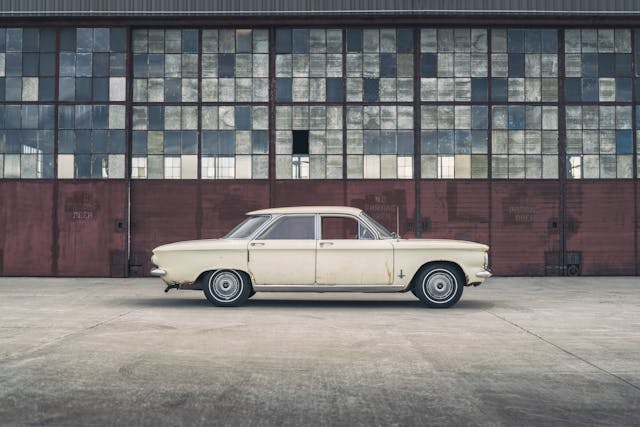
Yet I still wondered about the Corvair. Let’s forget about the controversy for a moment and consider the machine.
Gestated when General Motors was the undisputed king of carmakers, with over 50 percent of the U.S. car market, the Corvair was GM’s attempt to anticipate the future. It was a compact car but cleverly engineered to maintain interior space thanks to an air-cooled flat-six engine in the rear. In short, the 1960 Corvair was a complete rethink of the automobile and three years ahead of the Porsche 911.
GM bet big on the car with a whole family of body styles, including a sedan, a fetching coupe, convertible, wagon, van, and pickup. If Elon Musk had been behind it, he would have been called a genius. Today, these innovative and interesting cars are classic-car bargains, with solid, driver-quality examples available for 20 grand or less.
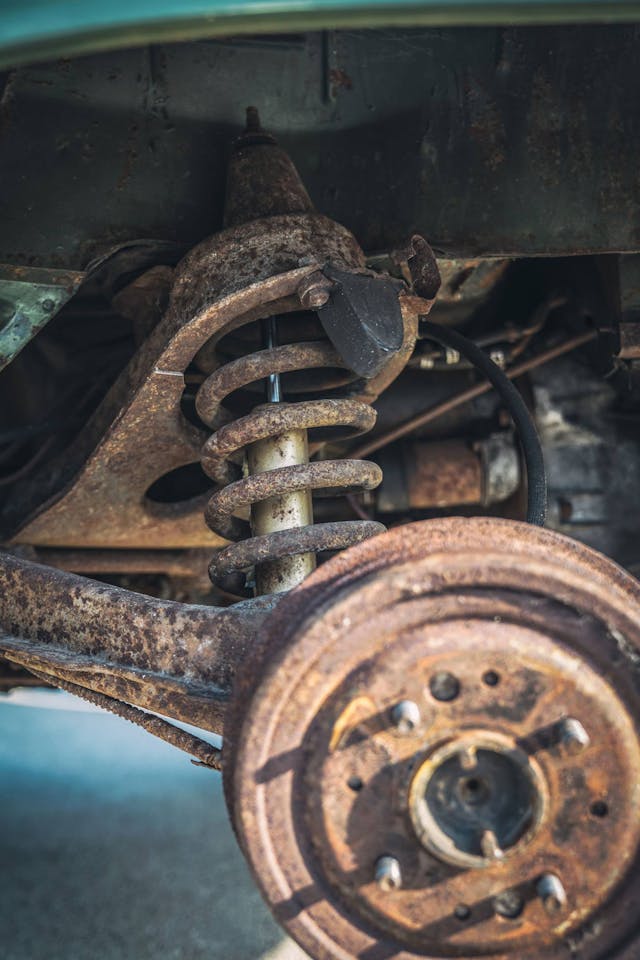
The Corvair was a revelation when compared to the lumbering oafs of the day. But its Achilles’ heel was that rear suspension, which was designed with economy in mind and was similar to the setup on the VW Beetle. A pair of short halfshafts connected the wheels to the frame-mounted differential. Only the inboard ends of the shafts could articulate, so as the suspension compressed or extended, the wheels tilted at extreme angles. This had the effect of dramatically reducing the rubber on the road. In an aggressive turn, the rear end tended to lose traction before the front, causing oversteer, or fishtailing.
That wasn’t all, however. There was a chance, a slim one, that the outside rear wheel could tuck in under the body and potentially trip the car into a rollover. These effects were further exasperated when owners failed to heed the Corvair’s unconventional recommended tire pressures: 15 psi in the front and 26 psi in the rear.
As I drive around the runway, gingerly at first to get a feel for the car, I’m shocked at how small and agile it feels. There’s no power steering yet the wheel doesn’t require much more effort than a modern car, even at parking-lot speeds. The same goes for the brakes. The suspension is soft, but compared to my 1955 Ford Country Squire, the oldest car in my fleet, the Corvair is a Ferrari. It’s fun.

In addition to Koehler, retired Chevrolet engineer Jim Musser is on hand. Musser spent his career in the research and development department. He worked on improving the Corvair and also prepared the defense for the court cases. He eventually succeeded Frank Winchell as the head of R&D. I gut-checked my plan with him, and he replied that race drivers of the day actually liked the Corvair. To make sure my test Corvair was as representative as possible, Coker Tire supplied a set of bias-ply tires, just like the car had in 1960.
I pick up speed and simulate a slalom course, driving back and forth across the center line. The harder I turn the more the back end feels light. Increasing the speed only exacerbates the effect, to the point where the back end clearly wants to make the turn faster than the front. To avoid spinning the car, I have to counter-steer almost immediately after initiating the turn. To racers, this behavior is known as “loose,” and it’s generally preferred to a front end that simply understeers, or plows. But I could see how the lightly trained driver might get into trouble.
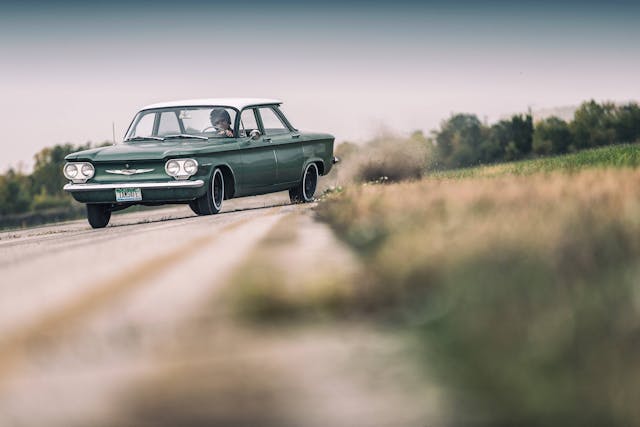
That was Nader’s point: The average driver wasn’t equipped to handle an over-steering car. Since a slalom isn’t very representative of normal driving, I navigate a course of varying turns, from simple right-angle bends to longer sweepers. At moderate speeds, everything’s fine. When I go fast enough to overcome the traction of the tires, however, the back end does its thing. On those skinny 1960s-era tires, speed is a relative term. Arcing through a corner at a velocity any modern car would scoff at, the Corvair starts to slide. The manual steering is slow by today’s standards so catching the thing requires huge movements of the wheel. The Corvair is a drift machine.
There’s a critical point to make here about oversteer that deserves mention. Bad oversteering cars snap out the rear end without warning. There’s no transition between equilibrium and chaos. I’ve raced cars with poorly set-up suspensions that had buckets of snap oversteer, and every one was a horror show. The Corvair’s behavior, however, is gradual. There’s ample warning of the rear-end movement and plenty of time to catch it. I gleefully slide the thing, hamming it up for the photographer, who stops me after I pass.
“How is that outside tire not buckling under the car?” he asks.
Through his camera’s viewfinder he points out extreme angles of the rear suspension. The inside rear wheel had lifted off the ground and the outside wheel was riding on the sidewall. We have a look at the rear tires and there are scuff marks right up to the whitewall, yet the tread of the tires looks pristine. Odd. We shrug it off and I do a few more passes. Only the engine’s lack of horsepower keeps me from hanging the rear end out continuously. I discover I can do U-turns simply by lifting off the gas and cranking over the steering wheel. The Corvair pivots around in not much more than the width of one lane. I could do this all day.
Real life, however, is never as ideal as a trained driver on a closed course in a perfectly prepared car. Let’s imagine someone misjudges a turn and enters it too fast. Perhaps this person hasn’t correctly maintained the tire pressures. Then what? I’d wager that the car’s going to spin. Is that worse than the alternative? Say another driver does the same thing in a 1960 Chevy Impala. The Impala probably wouldn’t spin but instead just simply not make the turn at all.
Since every situation is unique, it’s impossible to say which outcome is preferable. Between the two, however, the more agile Corvair probably has the better chance of avoiding that ball that rolled into the street.
In 1971, the U.S. Department of Transportation tested the original Corvair alongside competitive cars and determined that it was not especially dangerous. By then the Corvair had been out of production for two years and the affair was mostly over. And it had not been pretty. In addition to the rash of product liability lawsuits, Nader successfully sued GM for invasion of privacy in 1966, after the company had him followed. This had the effect of further publicizing Unsafe at Any Speed.
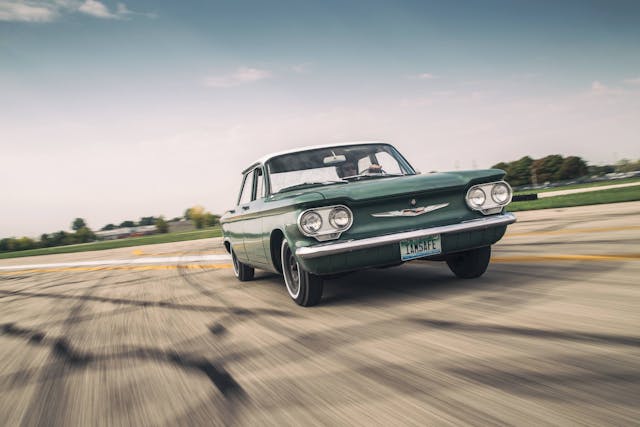
The pity of it all is the black eye on what was and is an interesting car. To me—and undoubtedly to Corvair enthusiasts—the history is part of the appeal. Every conversation with Musser or Koehler yielded another interesting layer.
Here’s one: In 1962, during the first Corvair lawsuit—three years before Nader’s book—two of history’s most accomplished racing drivers, Sir Stirling Moss and Juan Manuel Fangio, took the stand to defend the car. Another: The Corvair helped cement the relationship between Chevrolet and Jim Hall, the Texas builder of the Chaparral Can-Am cars. How? Musser rented Hall’s racetrack to gather the data needed to defend the lawsuits. Those tests, by the way, advanced the industry’s knowledge of vehicle dynamics.
The curious thing is that by the time Nader’s book came out, Chevrolet had already evolved the Corvair with a second generation that featured a redesigned rear suspension. By then, however, the writing about the car’s fate was already on the wall, independent of Nader’s book. There was also the Mustang, which probably had more to do with the Corvair’s demise. The stylish and sporty sales monster was cheap to produce, especially when compared to the Corvair and its costly aluminum engine. The irony of the Corvair, says Musser, is that GM kept the Corvair around for longer than it otherwise would have, just to avoid the appearance of being influenced by a young lawyer.
As for my experience behind the wheel? I’m shopping.
***
Check out the Hagerty Media homepage so you don’t miss a single story, or better yet, bookmark it. To get our best stories delivered right to your inbox, subscribe to our newsletters.


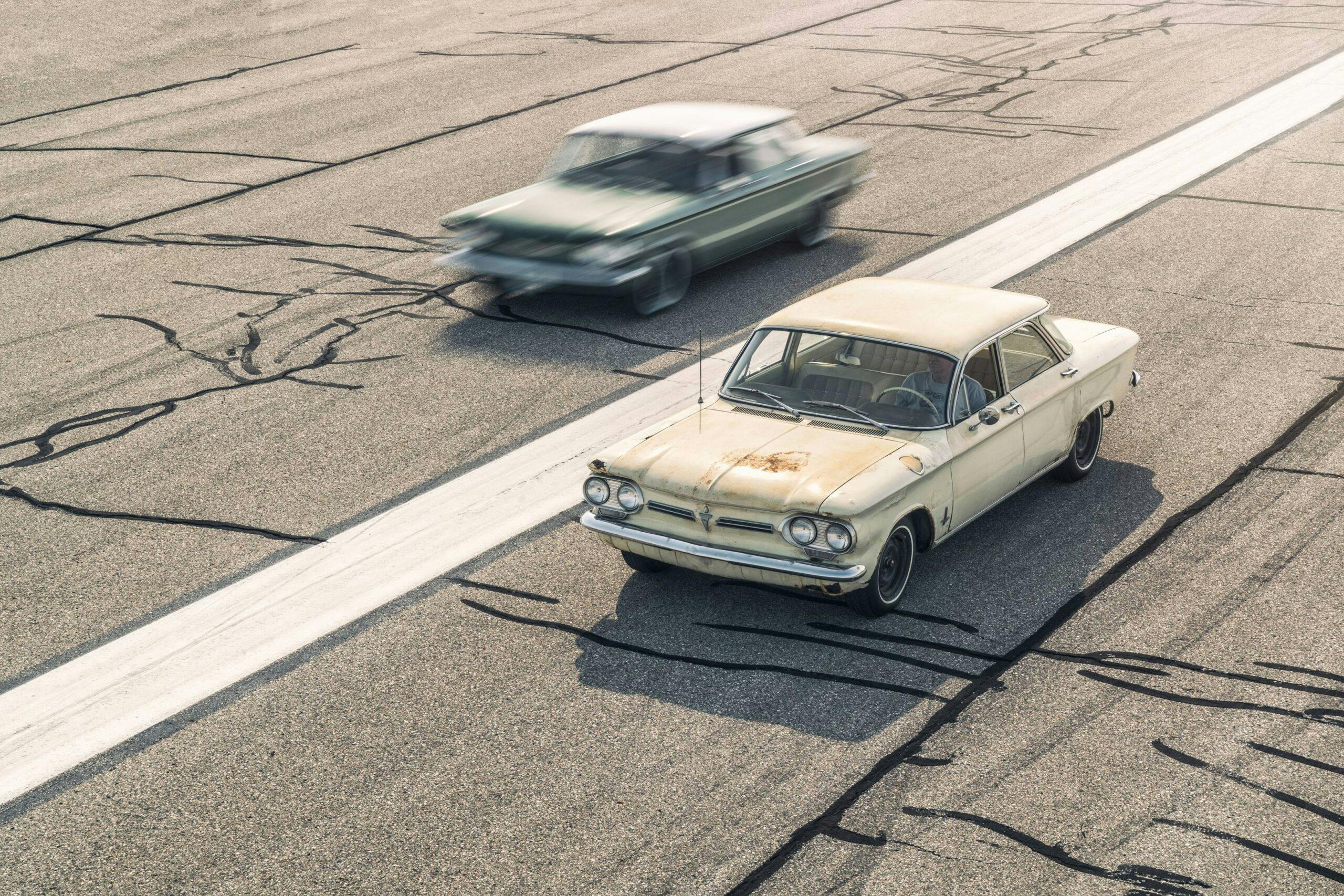
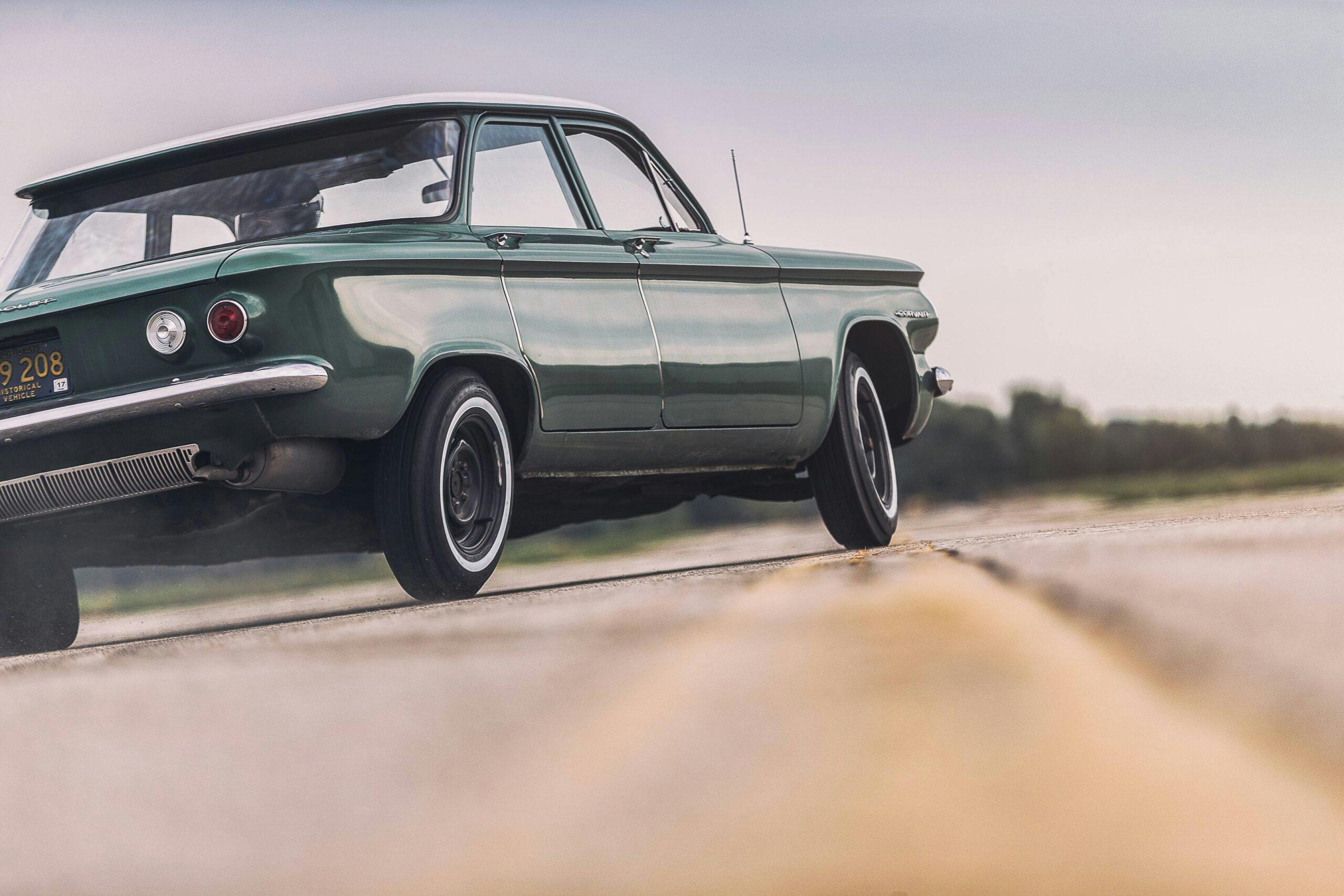


Cornering on 3 wheels. Just like the Rabbit GTI and how many others?
Except that Rabbit is understeering at that point, not oversteering, correct?
I learned how to drive on my Dad’s 68 Corvair. It was no more dangerous then most cars. What i do remeber is the odd automatic transmission lever on the dasboard
The 1968 had the revised rear suspension, unlike the earlier models with the swing arm type.
And the revised rear suspension kept the rear wheels perpendicular to the road, same as a conventional rear drive axle. My 66 (I think) Corsa was a real kick to drive on winding roads. On the freeway, the front end got light at about 95mph though. Probably a good thing… over about 75 the aerodynamics fought against the cooling system and it tended to run hot. If you shut it down without a cool-down period it tended to pop out a exhaust valve seat insert when restarted. (this was the 4-carb engine, this happened three times before the machine shop enlightened me) It was fun to drive but I graduated to airplanes to entertain myself. Less traffic. Less dangerous too.
As a result, GM and others became so afraid of oversteer that the El Camino wasn’t available with a rear sway bar.
We had a 1961 (as memory serves me) Pontiac Tempest that had the same independent rear suspension and the same surprise awaiting when pushing it too hard in a curve. It wasn’t deadly…. unless you were meeting another auto in a blind curve, then things got interesting. Fun little car, didn’t kill us kids, but it did land my sister in the ditch once.
lies lies and statistics.. recall reading a book forever ago reviewing Nader’s crusade against the Corvair… [ and vw beetle etc ] where he went on to say/bend/twist the readers interpretation with creative writing while maintaining the illusion of truth… IE ‘ the Impala fender cost xx per pound while the beetle/corvair etc fender costs xxxxxx per pound… what is omitted is the total cost.. impala’s 200 pound fender cost three times as much as beetle/corvair etc fender which weighted far far less… crap like that destroy[ed] his credibility.. lying by omission doesn’t help either… so many good ideas and lost on the one cause…. oh well can hardly wait for the new Nader emerging from these ‘quality’ [sic] electric vehicles emerging now.. ya know because the brands as SOOOO good with the basic mechanical ones we have had for a century or so… should be fun!
My grandfather was a GM exec in the 1960’s and a Corvair lover. He had a new one every year while my grandmother drove the “company cars”. I owned two of his. Int he 1970’s in high school I drove a 1964 4 door 110hp Monza handed down from him to my mother to me. What a laugh fest when I parked next to all the muscle cars in the high school lot. And more so in a straight line race!! But get back in the neighborhoods and I could leave those boys in all the corners and curves. (Most of them had their rear ends lifted which sure didn’t help them but I sure enjoyed my turn to laugh.) I pushed that car hard and never had the rear end break loose and it did not take long to get an idea of how it handled. Now I own his last Corvair, a 1966 140 hp Monza convertible with power top, AC, telescoping wheel and many more options. The car was his retirement gift from GM ordered by his boss. I drove it hard too when I was younger and though the body did flex it was a fine handling car. The Nader story is a long one and I heard it many times. Basically the crux of the story centered around an accident where the car was severely overloaded, 4 overweight women, trunk and roof rack full of heavy bags, under inflated tires and possibly speeding down a twisty mountain road. The driver lost control of the car, exited the road and rolled down the hill. All four women survived but were badly maimed. Perfect background for a young nobody like Nader to make a name for himself.
I wonder what the Corvair would have become…………
Chevy produced 5 prototype 235hp normally aspirated engines for the car. A collector in Florida had one still in its crate. I think the car was going somewhere.
Final thought; in the 1960’s the saying was “Good for GM, good for the country”. Does anyone really think an obscure little _______ like Ralph Nader could force GM to shut down a multi million dollar factory (Willow Run) and production line? Nader was never that powerful.
What does not add up: the 235hp engine development and the decision to end production.
I’ve never heard of these prototype 235hp engines. Do you have any information regarding those or where the one you know of is located?
The owner’s name was Tony Fiore, he was the president of the Gulf Coast Corvair Club a chapter of CORSA. He published a book titled “The Corvair Decade”. I have searched the book for mention of these engines but have not found any thing specific. Perhaps the Monza GT??
Tony passed on decades ago and the club chapter folded upon his death. He was the do everything guy and totally passionate about Corvairs. His Widow is gone now too and the home sold. I have no idea about the disposition of his collection as I was away pursuing my own career at that time.
I have “The Corvair Decade” book by Tony Fiore and another, “Corvair By Chevrolet: Production and Experimental Cars, 1957 – 1969” by the Ludvigsen Library, with an intro by Ed Cole, “father” of the Corvair and the first Cadillac OHV V8 and the first Chevy small-block V8. It’s likely long out of print as I got it in the 1980s. An intro by Cole puts its original release back in the early 1970s, before his untimely death. The book has a picture of the GM prototype of the Porsche-like Corvair engine with overhead cams (driven by rubber cog belts like the ground-breaking Pontiac OHC Six, the first production engine with them). It was described as capable of 240 hp at 7500 rpm. There were three carbs per bank and it had separate centrifugal cooling fans for each bank. Wherever it is now, it’s a priceless piece of “what if” American automotive history. Too bad there is no picture upload feature here as I have the picture scanned…
I guess your moderators did not like my response. Don’t know why. Email me if you would like and I’ll do my best to replicate it.
Note, though, that the 1964 had a somewhat modified swing-arm setup; from what I have read, it was better than the 1960-63 suspension, but not as good as the 1965-69.
@Rider79…You’re correct. The ’64 rear suspension set-up was “leaf spring like” mounted in reverse (ie: upside down) whereas the ’65-’69 was a “torsion bar” set-up.
I like the Corvair, but would avoid the whole suspension issue by buying the second-gen model, with its improved rear suspension and much sleeker styling. Too bad they never made a station wagon version of it, though!
???? Did they not make a station wagon by 1964 ?
Like the lost number 6000 Corvair, the 240 HP Boxer engine would be a real interesting update to the current info…..the supposed Boxer 8 cylinder that GM built would also add to the story.
Thanks for this Larry – very interesting and informative. The video shows ‘Episode 1’ was there an episode 2?
When I was in college I had a ’62 Monza coupe with a 4 speed transmission and a pair of those trombone exhausts that were popular on those cars in the early 60’s. I remember one night showing off with my Corvair and ending up facing the opposite direction after purposely cranking the wheel back and forth and inducing a spin. I also remember going into a mountain curve too hot and spinning off the road and into a ditch. Since I was on the inside of the curve I was lucky to not be driving that imaginary Impala which would have plowed across the opposite lane and maybe over the edge. I loved that little car! So did my friends to the degree that three of them bought ’63 and ’64 Monzas. It always ticked me off that Nader had ruined the car’s reputation after Chevrolet had corrected the swing axle “problems” that were clearly driver induced. I replaced the Monza with a ’64 Falcon Sprint which was the father of the Mustang. I liked that car a bunch too, but I still remember my little Monza coupe fondly.
Ah,yes, the 1964 Falcon Sprint. I bought one with a rod through the block back years ago. While searching salvage yards, I came across a black and gold mustang. The rocker stripe said “Hertz”. The owner since it was obviously a rental car, driven hard and such, he let me have the engine cheap. I bought the engine and transmission and put them in the Sprint, now no longer a 260 cid. I sold it a couple of years later, never knowing what I really had. Of course, this was in the mid 60’s, when one could buy a new AC Shelby Cobra for less than 8 thousand dollars. Usually less than that, is the dealer wanted to get it off the lot. Like the SuperBird, they didn’t sell all that well back then. Who knew?
“if”
Hey Author! Confused about exacerbated and exasperated? I know Larry Webster knows the difference. So who really wrote this article? Larry WebsterGPT?
Like the lost number 6000 Corvair, the 240 HP Boxer engine would be a real interesting update to the current info…..the supposed Boxer 8 cylinder that GM built would also add to the story.
Fun auto to drive, I remember camber compensators and limiting straps advertised in the early 1960s car magazines so the idea of a fix on wheel tucking was out there. However a lot of folks did not read the owners manual specially tire pressure…….of course gas station jockeys didn’t either…
Great read and very interesting research results. Well done and fun to remember some personal links. My older brother bought a family friend’s 62 coupe – he then went and painted it actual John Deere green from a can with a 5 inch brush. He called it the “ lizard “. The Corvair was his daily driver to keep the miles off of his ‘62 Porsche roadster…… also green but in pristine condition and not brush painted!
Do you think he was keeping the driving sensation similar between the two very diverse vehicles? I do now that I have read your article and excellent pix – he loved pushing his vehicles in the
“twisties” as he called them .
Many thanks!
What most people don’t realizes is that the Volkswagen Beetle was doing very well those years, It was thought having a American version of the Beetle by having the same mechanical layout with modern American body design. The Ford Falcon a simple good looking compact sedan was introduce, and the Valiant, all were introduce at the same. The Falcon outsold both! In ’62 the Chevy ll was introduce, Chevy version of the Falcon simple car, the Valiant in ’63 was resigned more like the Falcon also.
In ’65 the new second generation Corvair was a good-looking design car with the advance multi joint rear axle and other improvement, BUT the new Mustang with Falcon mechanicals with looks of a mini Thunderbird, was a winner at $2300+! The start of the Pony Car era! End of the Corvair in ’69.
What Corvair aficionados don’t get is that another reason for the Corvair’s demise was oil leaks and poor build quality, problems the VW Beetle did not have. The sealing on the heater would fail and
leak exhaust fumes into the interior. I know from the 1965 Corvair Monza I purchased in 1967. It
was replaced with a 1969 Datsun 510, which was also fun to drive, but much more reliable!
yes indeed. Also exhaust leaks which put exhaust gas into the cabin, especially on the high performance engine. That was the main reason I got rid of mine.
The oil leaks were solved early by Corvair owners… Vitron “O” rings on the push rod tubes solved that problem. Build quality was only at the end when Chevrolet was using up parts. Exhaust fumes were only
a problem if the owner failed to maintain the vehicle….. that is like saying a water cooled car leaks water (when the radiator hose fails) The Corvair “died” because it could not keep up with he HP race. Chevrolet
Released the Chevy II in ’62 and a year later it had a V8, come 1967 Chevy released the Camaro and there
was no room in the Chevy garage for the Corvair.